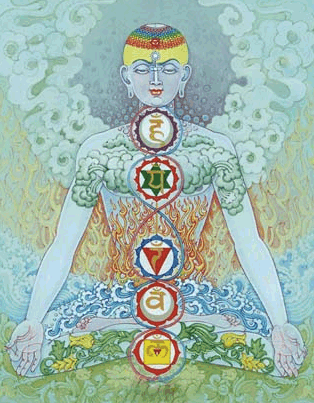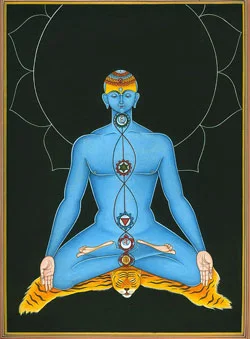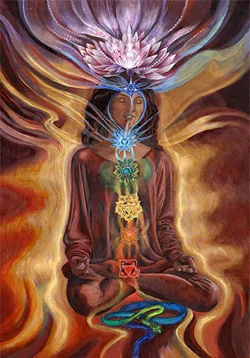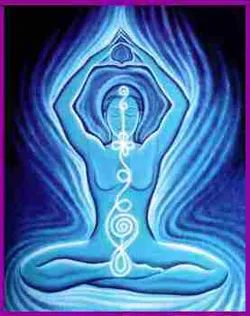Kundalini is the energy that exists in a latent state in man at the base of the spinal column. When this force is “awakened”, it springs upwards (or downwards if the person is practising the headstand position ''Shirshasana''). It moves along the central axis of the body (the spinal column) towards the crown or lotus on the top of the head (Sahasrara chakra).
Yoga tradition mentions the existence of 7 energetic centres (chakras), whose levels comprise the steps or phases of the process of creation. When rising from one level to another, Kundalini is given different names, according to the chakra where it settles. For instance, in the heart chakra (Anahata), Kundalini is called Hamsa and in the chakra in the middle of the forehead (Ajna) it is called Bindu. Sometimes Kundalini can ascend so much that it goes beyond the top of the head. Here it creates a mystical state ofconsciousness of indescribable ecstasy with duality no longer existing.
Kundalini is present in the body of every man as the aspect of Transcendental Power that precedes and penetrates the whole Macrocosmos. This power exists everywhere in the Universe, even in a tiny atom, “coiled” in the nucleus. Matter, life, consciousness and the supra-consciousness are only different degrees (that also manifest as different frequencies of vibration) of the revealation of the dormant power of Kundalini. Divine power (MahaVidya) embodies itself into individual souls, attaining limits in time and space, but also into matter, becoming coiled into itself, or in other words becoming asleep. The transcendental state is only realized when Kundalini completely ascends from the base to its ideal location at the top of the head and beyond it.
Awakening and Raising Kundalini
As in all ancient spiritual teachings of the world, Integral Yogaregards the human being as a genuine reflection of themacrocosm. Unobstructed, unlocalised universal power is presentin man in a place corresponding to the base of the spine in the analregion. It is associated with the earth element, the sense of smelland the general distribution of vital force (prana) in the body (muladhara chaka). When Kundalini ascends towards the top of the head,beatitude is experienced and a very intense light is perceived. Thelight that accompanies Kundalini’s awakening is one of theessential spiritual experiences as revealed by mystical persons of allreligious traditions.
In 1971, Gopi Krishna confirmed thefollowing: “Every time I focus the eye of mental knowledge upon myinner being, I invariably perceive an intense light inside and outsidemy head, as if a shining and extremely subtle substance has ascendedthe spinal column and spread inside and outside theskull, filling it upand surrounding it with indescribable radiation”.
When awakened, the Kundalini energy can ascend along three channels: Sushumna in the centre, and the other two, Ida and Pingala,coiled around it, which all join together in Ajna chakra. According totraditional explanations, the channel on the right performs thefunction of “warming up”the body, while the left channel “cools” itdown. From a physiological point of view, these energetic routescorrespond to the two nervous systems: sympathetic and parasympathetic.
Tantra and Hatha-Yoga texts are very categorical about the fact that onceawakened, Kundalini must be directed only through the main channel, inorder to avoid the unpleasant or even dangerous secondary effects.During the ascent, the chakras (subtle centres of force) become activeand according to certain authorities, this is the only time when theybecome alive. Passing through every centre, Kundalini temporarilyenergises it and then travels further, absorbing its energy. As Kundalini reaches the next chakra, the rest of the body is de-energizedand the lower extremities tend to go cold and lifeless.
Thesephysiological phenomena are in a striking contrast to the intense stateof beatitude, light and super-lucidity felt when Kundalini penetratesSahasrara. This experience is not cataleptic, but rather the shapelessecstasy of Nirvikalpa Samadhi.
At first the complete ascent of Kundalini lasts only a very short period of time (in seconds orminutes). This gigantic force descends then into one of the lowerchakras. Until Kundalini is established for good in the crown centre (Sahasrara), the aspirant must try to experience these elevated statesas often as possible. Usually the yogi is advised by his master toconsciously guide the descent of Kundalini and not allow it to go lowerthan heart centre (anahata chakra). Apparently Kundalini active in thefirst three centres is quite dangerous because it includes theamplification of the ego and an unrestrained sexual desire.
Traditionally,the awakening of Kundalini power is regarded as an intense purificationprocess that leads to the transcendence of the body and mind,ecstatically crowning the state of unification of the subject with theobject.
As Kundalini rises it encounters all types of impuritiesthat are burnt through by its dynamic activity. Sanskrit texts mentionthree major structural blockages, known as “knots” or granthi. According to tradition, these knots are located in the centre of the anal region (Brahma granthi), in the centre of the heart (Vishnu granthi) and in the centre between the eyebrows (Rudra granthi).
Kundalini can be blocked anywhere along its upward trajectory. These blockagesare in fact areas where tension is concentrated. Thus when Kundalini isascending it directs the central nervous system to remove theseblockages. This experience is usually painful. When Kundalini meetsthose blockages, it acts upon them until they are dissolved. Once theblockage is dissolved, Kundalini can freely flow on through that pointuntil it encounters another stressed zone. In addition, Kundalinienergy can be diffused so that it can act upon many levels at one time,simultaneously eliminating different areas of tension.
Kundalini moves upwards till it reaches the last chakra, Sahasrara. Although itmay scatter along the way, it becomes coherent when it gets to thiscentre. According to traditional Yoga and Tantra texts, this movementtakes place from the base of the spinal column, along the spinalaxis, corresponding to what Swami Muktananda and Gopi Krishna testify.However, some non-Hindu texts state that the route taken by Kundalinioriginates from the feet, to the legs, along the spinal column, to thehead, and then descends through the front along the neck, the chest andending in the abdominal zone.
In Charles Luk’s Tao Yoga,the “microscopic orbit” of the inner fire begins at the base ofthe spinal column, ascends towards the brain and from there returns tothe starting point. Nevertheless, the yogi who attempts the ancienttechniques of raising Kundalini relies on the classic model. He expectsthe energy to awaken in the lowest chakra and to rise towards the topof the head where it will generate ineffable ecstasy. It is then easyto explain why he can ignore any phenomenon that does not meet thesedescriptions.
Sensations and experiences in Kundalini
Yoga tradition distinguishes between the partial and the totalawakening of Kundalini. The partial awakening may lead to differentmental and physical experiences. However, the complete ascent ofKundalini towards the crown centre (Sahasrara) will give birth to thetrue impulse of God realisation (or spiritual liberation) and willbring the much-desired revolution of the consciousness. It is only thenthat the body can be transcended into the pure and perfect ecstasy ofenlightenment.
The awakening of Kundalini power is accompanied by different sensations and experiences:
One of the richest autobiographies is that of Swami Muktananda, amaster of the Siddha Yoga Indian
tradition who has attracted many western disciples. Regarding kundalini, he sometimes noticed his bodymoving involuntarily and other times he stood immobile in strangepositions. He also observed powerful energy currents in the body,unusual patterns of breathing, inner lights and sounds, terrifying visions and noises and many other extraordinary mystical phenomena.During meditation for example, he used to smell fragrancesand taste nectar and often experienced ecstasy.
He also noticedunpleasant secondary effects. “All my body was hot, my head felt heavy.Every single cell of my body started to groan.” He specifically noticedthat his anal area was very painful. Moreover, he mentioned that fromtime to time he was overwhelmed by sexual desire – a confession alsomade by the sufi disciple Irina Tweedie. The connection between thestimulation of the vital force and sexual energy is recognised by allesoteric traditions, especially Tantra and Taoism. Swami Muktananda’sperfecting of the Kundalini process required a few years. It reachedthe climax when he traveled beyond such experiences in order topermanently establish himself “in perfect peace and self-possession”.
In the incipient stages of Kundalini’s awakening, Swami Muktananda oftenused to be annoyed and afraid, having absolutely no control of hisbody’s movements. He felt clumsy performing yoga positions and dazzlinglights appeared in his head. For a while he believed he was losing hismind. It is easy to imagine the diagnosis he would have received had heasked a psychiatrist and not a guru (spiritual master). Once theinitial difficulties were overcome, everything progressed alongperfectly.
He later became a master himself and so could help manypeople on their spiritual path.
Another biography that tells of spontaneous awakening of Kundalini is that of Gopi Krishna, a teacherand superintendent in Kashmir. As a child Gopi Krishna had many psychic experiences. He however became agnostic but constantly practised meditation for many years. He did not have any further mystical experiences until 1937 when at age 34, he experienced aspontaneous awakening of Kundalini which radically changed his life.Since that time his consciousness remained awake, as a lighted area,increasing and decreasing mysteriously. Then in 1943 he had a powerful experience of Kundalini that lead to Samadhi.
He described this stateas: “I distinctly felt an incomparable sensation of beatitude in all mynerves. It moved from the tips of my toes and my fingers and otherparts of the body towards the spinal column where, concentrated andintensified, it ascended to the upper region of the brain. Thus it mademe feel even better. I felt the beatific and frantic torrent of anextremely rare radiant neuron secretion. In the absence of a moreadequate name, I called this “nectar”…”
 This ineffable sensationdisappeared when he focused his attention upon it, but it continued toflow even more intensely when he ignored it. Unexpectedly, he felt astream of liquid light, murmuring like a waterfall, entering the brainthrough the spinal channel. His body started to shake and he wassurrounded by a halo of light. He became one with the surroundingenvironment and he felt overwhelmed by ecstasy.
This ineffable sensationdisappeared when he focused his attention upon it, but it continued toflow even more intensely when he ignored it. Unexpectedly, he felt astream of liquid light, murmuring like a waterfall, entering the brainthrough the spinal channel. His body started to shake and he wassurrounded by a halo of light. He became one with the surroundingenvironment and he felt overwhelmed by ecstasy.
These werefollowed by feelings of terror, weakness and indifference towardsothers. There was a bitter taste in his mouth, his throat was dry andburning, he felt his body was pierced by countless hot needles, andsuffered insomnia. In the dark he could distinguish a reddish lightsurrounding him. From time to time, he endured back pains. He thoughtKundalini was operating abnormally and that he could die.
Oncethe Kundalini process started within him, Gopi Krisha was completely atits discretion. Many years had to pass for him to reach physicalequilibrium and an inner calm state. When Kundalini was established,Gopi Krishna obtained extraordinary mental powers that he graduallyperfected, such as mental creativity and complete serenity.
Yoga tradition mentions the existence of 7 energetic centres (chakras), whose levels comprise the steps or phases of the process of creation. When rising from one level to another, Kundalini is given different names, according to the chakra where it settles. For instance, in the heart chakra (Anahata), Kundalini is called Hamsa and in the chakra in the middle of the forehead (Ajna) it is called Bindu. Sometimes Kundalini can ascend so much that it goes beyond the top of the head. Here it creates a mystical state ofconsciousness of indescribable ecstasy with duality no longer existing.
Kundalini is present in the body of every man as the aspect of Transcendental Power that precedes and penetrates the whole Macrocosmos. This power exists everywhere in the Universe, even in a tiny atom, “coiled” in the nucleus. Matter, life, consciousness and the supra-consciousness are only different degrees (that also manifest as different frequencies of vibration) of the revealation of the dormant power of Kundalini. Divine power (MahaVidya) embodies itself into individual souls, attaining limits in time and space, but also into matter, becoming coiled into itself, or in other words becoming asleep. The transcendental state is only realized when Kundalini completely ascends from the base to its ideal location at the top of the head and beyond it.
Awakening and Raising Kundalini
As in all ancient spiritual teachings of the world, Integral Yogaregards the human being as a genuine reflection of themacrocosm. Unobstructed, unlocalised universal power is presentin man in a place corresponding to the base of the spine in the analregion. It is associated with the earth element, the sense of smelland the general distribution of vital force (prana) in the body (muladhara chaka). When Kundalini ascends towards the top of the head,beatitude is experienced and a very intense light is perceived. Thelight that accompanies Kundalini’s awakening is one of theessential spiritual experiences as revealed by mystical persons of allreligious traditions.
In 1971, Gopi Krishna confirmed thefollowing: “Every time I focus the eye of mental knowledge upon myinner being, I invariably perceive an intense light inside and outsidemy head, as if a shining and extremely subtle substance has ascendedthe spinal column and spread inside and outside theskull, filling it upand surrounding it with indescribable radiation”.
When awakened, the Kundalini energy can ascend along three channels: Sushumna in the centre, and the other two, Ida and Pingala,coiled around it, which all join together in Ajna chakra. According totraditional explanations, the channel on the right performs thefunction of “warming up”the body, while the left channel “cools” itdown. From a physiological point of view, these energetic routescorrespond to the two nervous systems: sympathetic and parasympathetic.
Tantra and Hatha-Yoga texts are very categorical about the fact that onceawakened, Kundalini must be directed only through the main channel, inorder to avoid the unpleasant or even dangerous secondary effects.During the ascent, the chakras (subtle centres of force) become activeand according to certain authorities, this is the only time when theybecome alive. Passing through every centre, Kundalini temporarilyenergises it and then travels further, absorbing its energy. As Kundalini reaches the next chakra, the rest of the body is de-energizedand the lower extremities tend to go cold and lifeless.
Thesephysiological phenomena are in a striking contrast to the intense stateof beatitude, light and super-lucidity felt when Kundalini penetratesSahasrara. This experience is not cataleptic, but rather the shapelessecstasy of Nirvikalpa Samadhi.
At first the complete ascent of Kundalini lasts only a very short period of time (in seconds orminutes). This gigantic force descends then into one of the lowerchakras. Until Kundalini is established for good in the crown centre (Sahasrara), the aspirant must try to experience these elevated statesas often as possible. Usually the yogi is advised by his master toconsciously guide the descent of Kundalini and not allow it to go lowerthan heart centre (anahata chakra). Apparently Kundalini active in thefirst three centres is quite dangerous because it includes theamplification of the ego and an unrestrained sexual desire.
Traditionally,the awakening of Kundalini power is regarded as an intense purificationprocess that leads to the transcendence of the body and mind,ecstatically crowning the state of unification of the subject with theobject.
As Kundalini rises it encounters all types of impuritiesthat are burnt through by its dynamic activity. Sanskrit texts mentionthree major structural blockages, known as “knots” or granthi. According to tradition, these knots are located in the centre of the anal region (Brahma granthi), in the centre of the heart (Vishnu granthi) and in the centre between the eyebrows (Rudra granthi).
Kundalini can be blocked anywhere along its upward trajectory. These blockagesare in fact areas where tension is concentrated. Thus when Kundalini isascending it directs the central nervous system to remove theseblockages. This experience is usually painful. When Kundalini meetsthose blockages, it acts upon them until they are dissolved. Once theblockage is dissolved, Kundalini can freely flow on through that pointuntil it encounters another stressed zone. In addition, Kundalinienergy can be diffused so that it can act upon many levels at one time,simultaneously eliminating different areas of tension.
Kundalini moves upwards till it reaches the last chakra, Sahasrara. Although itmay scatter along the way, it becomes coherent when it gets to thiscentre. According to traditional Yoga and Tantra texts, this movementtakes place from the base of the spinal column, along the spinalaxis, corresponding to what Swami Muktananda and Gopi Krishna testify.However, some non-Hindu texts state that the route taken by Kundalinioriginates from the feet, to the legs, along the spinal column, to thehead, and then descends through the front along the neck, the chest andending in the abdominal zone.
In Charles Luk’s Tao Yoga,the “microscopic orbit” of the inner fire begins at the base ofthe spinal column, ascends towards the brain and from there returns tothe starting point. Nevertheless, the yogi who attempts the ancienttechniques of raising Kundalini relies on the classic model. He expectsthe energy to awaken in the lowest chakra and to rise towards the topof the head where it will generate ineffable ecstasy. It is then easyto explain why he can ignore any phenomenon that does not meet thesedescriptions.
Sensations and experiences in Kundalini
Yoga tradition distinguishes between the partial and the totalawakening of Kundalini. The partial awakening may lead to differentmental and physical experiences. However, the complete ascent ofKundalini towards the crown centre (Sahasrara) will give birth to thetrue impulse of God realisation (or spiritual liberation) and willbring the much-desired revolution of the consciousness. It is only thenthat the body can be transcended into the pure and perfect ecstasy ofenlightenment.
The awakening of Kundalini power is accompanied by different sensations and experiences:
- If the energy is awakened and ascends through Pingala Nadi, a powerful sensation of warmth appears along the back at first and then in the whole body. On the other hand, if the energy ascends through Ida Nadi, a sensation of coldness is perceived.
- When Kundalini enters the central spinal channel, called Sushumna, a specific sensation of unification appears in the whole being and the respiration may stop for a short time.
- When Kundalini reaches Anahata chakra, heart palpitations can be observed.
- Sometimes itches can be felt in the fingers or the whole body may start to tremble. Tradition mentions that the ascent along the back to the top of the head can be felt in different ways: as the slow motion of an ant, the sinuous movement of a snake, the hopping of a small bird, the slow advance of a fish in calm water, or as the leap of a monkey to a distant tree.
- All these signs are mentionedin traditional Hindu scriptures,especially in Yoga and Tantra. The wiseyogi Ramakrishna, one of the greatest masters of mysticism in modernIndia, described his experiences regarding Kundalini in almost similarterms. Speaking of the different ecstatic states towards which he wasnaturally “inclined”, he said:
- "In these ecstatic states of Samadhi, the sensation of the Spiritual Current can be felt as the movement of an ant, of a fish, monkey, bird or snake. Sometimes, theSpiritual Current ascends through the spinal column, crawling like anant. Other times in Samadhi, the soul swims happily in the oceanof divine ecstasy like a fish. When I recline on my side, I feel theSpiritual Current pushing me like a monkey and playing joyfully withme. I rest still. This current can reach Sahasrara in a single jump,like a monkey. That is why you see me springing up sometimes. Now andthen, the Spiritual Current goes up like a bird, hopping from branch tobranch. When it stops, I can feel it as a fire. Sometimes the Currentis slithering like a snake. Ascending in a zigzag line, it finallyreaches my head and I experience Samadhi. The spiritual consciousnessof a man is not awakened until Kundalini is ascended."
One of the richest autobiographies is that of Swami Muktananda, amaster of the Siddha Yoga Indian
tradition who has attracted many western disciples. Regarding kundalini, he sometimes noticed his bodymoving involuntarily and other times he stood immobile in strangepositions. He also observed powerful energy currents in the body,unusual patterns of breathing, inner lights and sounds, terrifying visions and noises and many other extraordinary mystical phenomena.During meditation for example, he used to smell fragrancesand taste nectar and often experienced ecstasy.
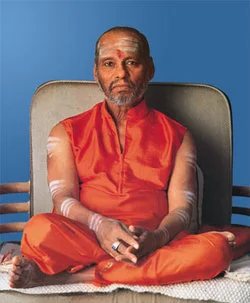 |
| Swami Muktananda |
In the incipient stages of Kundalini’s awakening, Swami Muktananda oftenused to be annoyed and afraid, having absolutely no control of hisbody’s movements. He felt clumsy performing yoga positions and dazzlinglights appeared in his head. For a while he believed he was losing hismind. It is easy to imagine the diagnosis he would have received had heasked a psychiatrist and not a guru (spiritual master). Once theinitial difficulties were overcome, everything progressed alongperfectly.
He later became a master himself and so could help manypeople on their spiritual path.
Another biography that tells of spontaneous awakening of Kundalini is that of Gopi Krishna, a teacherand superintendent in Kashmir. As a child Gopi Krishna had many psychic experiences. He however became agnostic but constantly practised meditation for many years. He did not have any further mystical experiences until 1937 when at age 34, he experienced aspontaneous awakening of Kundalini which radically changed his life.Since that time his consciousness remained awake, as a lighted area,increasing and decreasing mysteriously. Then in 1943 he had a powerful experience of Kundalini that lead to Samadhi.
He described this stateas: “I distinctly felt an incomparable sensation of beatitude in all mynerves. It moved from the tips of my toes and my fingers and otherparts of the body towards the spinal column where, concentrated andintensified, it ascended to the upper region of the brain. Thus it mademe feel even better. I felt the beatific and frantic torrent of anextremely rare radiant neuron secretion. In the absence of a moreadequate name, I called this “nectar”…”
 This ineffable sensationdisappeared when he focused his attention upon it, but it continued toflow even more intensely when he ignored it. Unexpectedly, he felt astream of liquid light, murmuring like a waterfall, entering the brainthrough the spinal channel. His body started to shake and he wassurrounded by a halo of light. He became one with the surroundingenvironment and he felt overwhelmed by ecstasy.
This ineffable sensationdisappeared when he focused his attention upon it, but it continued toflow even more intensely when he ignored it. Unexpectedly, he felt astream of liquid light, murmuring like a waterfall, entering the brainthrough the spinal channel. His body started to shake and he wassurrounded by a halo of light. He became one with the surroundingenvironment and he felt overwhelmed by ecstasy.These werefollowed by feelings of terror, weakness and indifference towardsothers. There was a bitter taste in his mouth, his throat was dry andburning, he felt his body was pierced by countless hot needles, andsuffered insomnia. In the dark he could distinguish a reddish lightsurrounding him. From time to time, he endured back pains. He thoughtKundalini was operating abnormally and that he could die.
Oncethe Kundalini process started within him, Gopi Krisha was completely atits discretion. Many years had to pass for him to reach physicalequilibrium and an inner calm state. When Kundalini was established,Gopi Krishna obtained extraordinary mental powers that he graduallyperfected, such as mental creativity and complete serenity.


